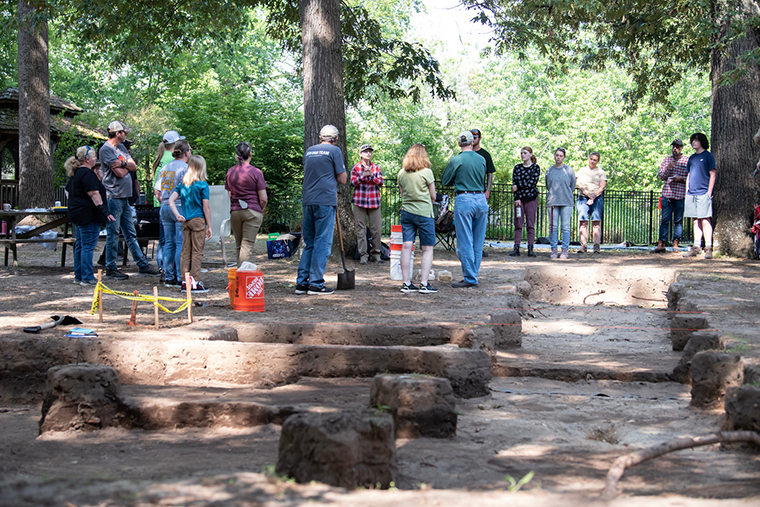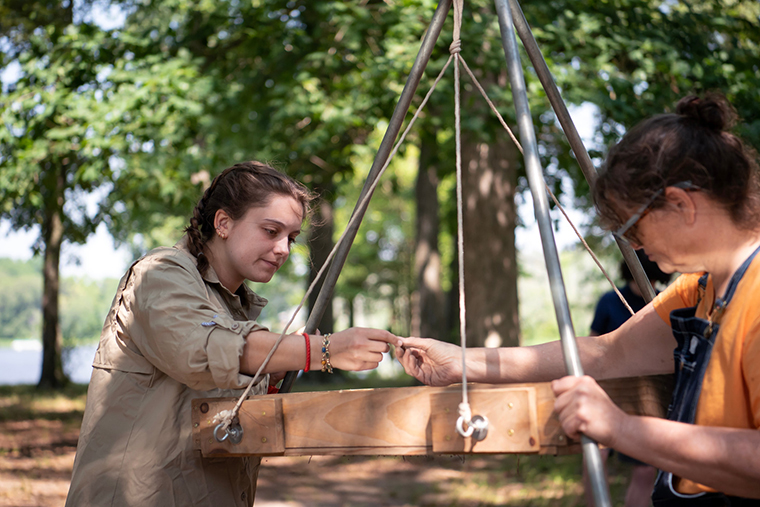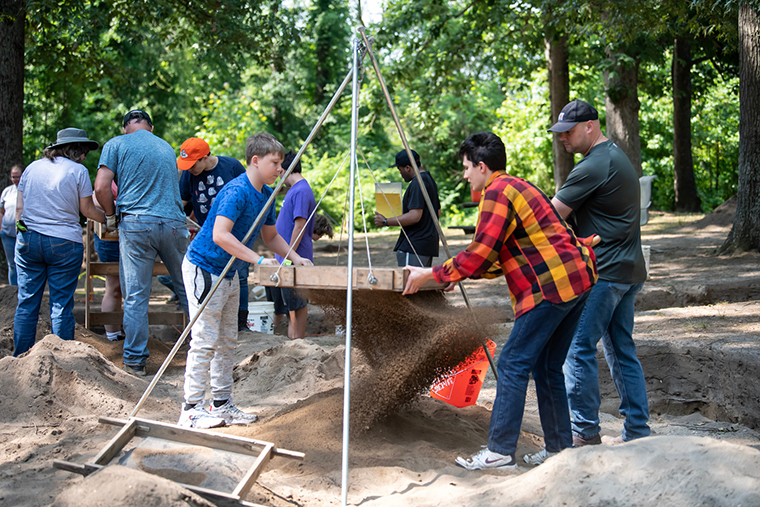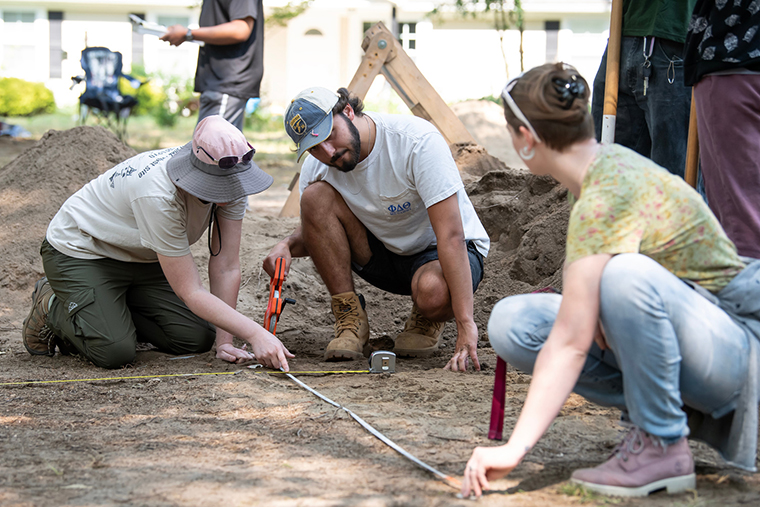Archaeology Field School Opens Site to Public
The summer course provides students from Washington College and elsewhere a hands-on opportunity to learn archaeology techniques and includes one day when students share what they’ve learned with curious members of the public who come to help on the dig.

Volunteers listen to instructions from professor Julie Markin while standing by archaeological units excavated to varying depths.
Down a gravel road and a few dozen yards from the Choptank River, piles of sandy soil sit next to two-meter-square areas dug to different depths. At the corners of the square pits, known as units, tags with latitude and longitude provide reference points for later mapping.
Throughout a beautiful Saturday in June, students from Washington College and University College London guided members of the public from rising eighth graders to retirees in carefully shoveling less than an inch of soil at a time into buckets, sifting every bucket through fine mesh, and collecting anything reflecting human activity on this site, which shows evidence of Native American use 1,000 to 4,000 years ago.
Julie Markin, associate professor of anthropology and director of Washington's archaeology program, teaches the class and oversees the dig site, orienting volunteers in the morning, preparing new sections for digging later, and providing details about a pottery shard at little more than a glance when walking past a volunteer and a member of the Archeological Society of Maryland discussing how experts can discern what is a fragment of an artifact from natural materials. (More than once throughout the day, students kindly told volunteers “that's a rock” as they sorted through materials on a sifting screen.)

“I set a public day within the field school every year” because positioning the College students to teach public volunteers gives them another way to learn, Markin said. “That helps them to understand archaeology and field work, the methods, and techniques better and even the reasoning why we're doing things because people will be asking them. It helps them to understand the process of archaeology better themselves, but also to then understand the value of engaging with the public.”
Helping the public to better understand how archaeology gets done and what it can teach us can build support for the work, according to Markin, whether in support for government research funding or in reporting finds and allowing archaeologists access to private property. American law says landowners also own the artifacts on their properties, but Markin points out there is little value in the objects themselves for individuals. The value arises from understanding where the objects were in relation to each other and in making them available for scientific study. (Both property owners involved in the field school site have signed deeds of gift turning over everything the effort finds to the state's archaeological conservation lab so current and future researchers can study it.)
Public volunteers have fun, learn about field, help research
Many of the volunteers attending the field school noted that they were intrigued by the techniques of archaeology they were learning, but the excitement and joy seemed to come from the hands-on work of collecting and screening artifacts, which were mostly pieces of pottery and “points,” a term covering complete or partial arrowheads, spear points, knives or other sharpened stone tools.
“It's cool to see how it really works. It was fun,” said Ché DeFord of York, Pennsylvania, who came to the dig with her mother, Diane Arthur. “I was surprised we found something. I like the pottery. You feel like a little kid running to an adult [for confirmation or identification of the artifact].”
Arthur said she is making time for her interests after reaching a point in her career where she can step back a bit, unlike when Ché was a child, and that she valued the opportunity that the field school's public day presented.
“You get a chance to be around people who know what they're doing, the experts, and learn from them and help them,” she said. “If I hit the lottery and didn't have to work, I'd fund the research so I could go along.”
Arthur's interest in helping the archaeologists is no exaggeration either, according to Markin.

“There is so much to do. I could do this full-time and still not do everything that people would ask,” Markin said. “That's why public archaeology is so essential. Archaeology is not a solo endeavor. It is a team sport. You need people to help put in the units. You need the hands to move the earth and to screen through it and then to analyze it.”
In addition to the students in the field school and the volunteers for the public day, Markin has had help with the research site from a two-week Archeological Society of Maryland (ASM) dig that she led before the field school began. Markin restarted the Eastern Shore chapter of ASM this past September after it had been moribund for years. She now serves as the chapter president in addition to her academic duties. Markin agrees that as well as a profession, archaeology is a labor of love for those who work in the field.
Jason Elder '19 served as a teaching assistant for the archaeology field school course immediately after his graduation and has returned to co-lead the course with Markin the past three years, initially taking time off work in cultural resource management with a private company, and this year flying back from Fairbanks, Alaska, where he just completed his first year of a master's program in archaeology focused on the earliest human occupation of North America.
“I just love working with Julie,” Elder said. "And being here on this site has been great the past three years because there is so much exciting stuff we've been finding and there is so much work we can do in the future.”
In addition to running the dig, Markin also ensured the volunteers got some of the context for the work they were doing. She noted at the start of the day that they have been finding many different pottery styles, kinds found not just on the Eastern Shore but on the Western Shore, out to Frederick, and from Delaware and Pennsylvania as well. As lunchtime neared, she gathered the volunteers at a picnic table and showed them artifacts found on the site earlier and at last year's field school, held just up the hill at a Colonial-era site, including English coins, a glass bead Europeans brought to trade with Native Americans, a bone die, and even mouth harps.
Field school provides essential preparation for students

Even as the members of the public gained in their appreciation for the work, the field school's primary benefits arguably go to the students, who are spending weeks on the site rather than hours. Daniel McDowell '26 has been interested in archaeology since he was a child and his mother found a way for them to get involved with research being done in advance of the Route 301 expansion outside Middletown, Delaware, where they live. The field school has given McDowell a better understanding of how the entire process of excavating and studying works, including how much documentation is involved for accurate research.
Oliver Heaton of Birmingham, England, is one of four University College London students working on the site this summer, completing some of the considerable number of hours of fieldwork required in British archaeology programs. He and fellow UCL student Caroline Cansfield of Toronto said the opportunity was exciting because North American archaeology is considerably different from British archaeology in both technique and subject matter.
“It's a far more methodical kind of digging,” Heaton said. “You're sieving through absolutely everything.”
One student utterly pleased to be sifting every grain of sand was Amy Cannon '25, who is embarking on a long-anticipated journey into archaeology.
The field school is the first course at Washington College for Cannon, who is transferring after earning her Associate of Science degree at Delaware Technical Community College. She brought her family for the public engagement day and will be working with Markin throughout the summer, potentially helping reassemble some of the pottery they have found and exploring potential sites for next year's field school.
“This I something I've wanted to do for as long as I could remember, ever since I was a little girl. I used to sit in my grandfather's basement reading National Geographic magazine, thinking ‘I want to go there,'” Cannon said. “This is a perfect place for me to start. Everybody is fantastic. They have been so helpful.”